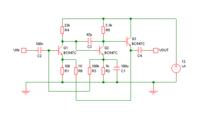diaz080
Member level 4
For understanding the concept of phase margin i need to design bjt amplifier with poor phase margin (oscillatory output) and then do compensation to make the amplifier stable. can anyone suggest me the method for doing this.
Follow along with the video below to see how to install our site as a web app on your home screen.
Note: This feature may not be available in some browsers.
Start by designing a simple amplifier with about 3 BJT gain stages, and apply negative feedback to set the voltage gain.
It will probably have stability problems. Now you can add compensation to fix the stability.

That will make it more stable, but I'm surprized there's no ringing.5v supply and 2n3904 transistor)
That will make it more stable, but I'm surprized there's no ringing.
Did you try the test I suggested in post 14, with different capacitors between output and ground?
For that matter, did you ever try simulating the circuit I actually showed in post 10, with the same supply voltage, same component values, same transistors etc? If so, did you try the test I suggested in post 14 with that?